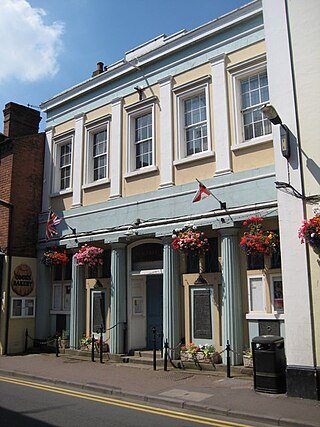
Wymondham is a market town and civil parish in the South Norfolk district of Norfolk, England, 12 miles (19 km) south-west of Norwich off the A11 road to London. The River Tiffey runs through. The parish, one of Norfolk's largest, includes rural areas to the north and south, with hamlets of Suton, Silfield, Spooner Row and Wattlefield. It had a population of 14,405 in 2011, of whom 13,587 lived in the town itself.

Gateley is a village and civil parish in the Breckland district of Norfolk, England.

Touchstones Rochdale is an art gallery, museum, local studies centre, visitor information centre and café forming part of the Central Library, Museum and Art Gallery in Rochdale, Greater Manchester, England. It is a Grade II listed building.

Rochdale Town Hall is a Victorian-era municipal building in Rochdale, Greater Manchester, England. It is "widely recognised as being one of the finest municipal buildings in the country", and is recorded in the National Heritage List for England as a designated Grade I listed building.

The Crescent is a street in Taunton, a town in the English county of Somerset. Construction began in 1807, during a period of extensive redevelopment in the town, driven by the Market House Society and the Member of Parliament Sir Benjamin Hammet. Lined on the eastern side by a Georgian terrace, the street follows a shallow crescent shape, broken in the middle by Crescent Way and a bit further south by St George's Place. It links Upper High Street, at its southern end, with Park Street and Tower Street to the north. On the western side, Somerset County Council have their offices in the County Hall, erected in 1935, and extended in the 1960s. The Georgian terrace, the Masonic Hall, and the County Hall are recorded in the National Heritage List for England as listed buildings.

Havering Town Hall is a municipal building in Main Road, Romford, London. The town hall, which is the headquarters of Havering London Borough Council, is a Grade II listed building.

Stratford Town Hall is a municipal building in Stratford, London. It is a Grade II listed building.

Batley Town Hall is a municipal facility in the Market Place in Batley, West Yorkshire, England. It is a Grade II listed building.

Hereford Town Hall is a municipal building in St Owen's Street, Hereford, Herefordshire, England. The building is a Grade II* listed building.

Thetford Guildhall is a municipal structure in the Market Place in Thetford, Norfolk, England. The town hall, which was the headquarters of Thetford Borough Council, is a Grade II listed building.

East Cowes Town Hall is a municipal building in York Avenue, East Cowes, Isle of Wight, England. The structure, which is the meeting place of East Cowes Town Council, is a locally listed building.

Beccles Town Hall is a municipal structure in New Market, Beccles, Suffolk, England. The structure, which accommodates the offices and meeting place of Beccles Town Council, is a Grade II listed building.

Garstang Town Hall is a municipal building in the High Street in Garstang, Lancashire, England. The structure, which currently accommodates two shops and a Royal British Legion Club, is a Grade II listed building.

Aylsham Town Hall is a municipal building in the Market Place in Aylsham, Norfolk, England. The structure, which accommodates the offices and meeting place of Aylsham Town Council, is a grade II listed building.

The Old Town Hall is a former events venue in Prince of Wales Road, Cromer, Norfolk, England. The structure, which is currently used for retail purposes, is a grade II listed building.

The Old Town Hall is a former events venue in Bridge Street, Loddon, Norfolk, England. The structure, which is currently occupied for commercial use, is a grade II listed building.

Withington Town Hall, also known as West Didsbury Town Hall, is a former municipal building on Lapwing Lane, Withington, a town in Greater Manchester in England. The building, which served as the offices and meeting place of Withington Urban District Council and now accommodates a firm of solicitors, is a Grade II listed building.

Eton Town Council Offices is a municipal building in the High Street in Eton, a town in Berkshire, in England. The building, which serves as the meeting place of Eton Town Council, is a locally listed building.

Upton-upon-Severn Memorial Hall, formerly known as Upton-upon-Severn Town Hall, is a municipal building in Old Street in Upton-upon-Severn, a town in Worcestershire in England. The building, which serves as the offices and meeting place of Upton-upon-Severn Town Council, is a Grade II listed building.

Swaffham Town Hall is a judicial building in Whitecross Road in Swaffham, a town in Norfolk, in England. The building, which is now in residential use, is a Grade II listed building.





















